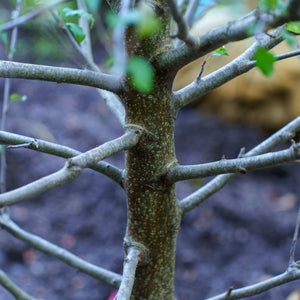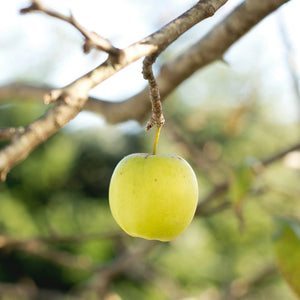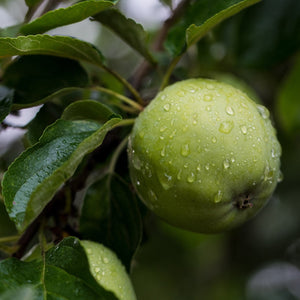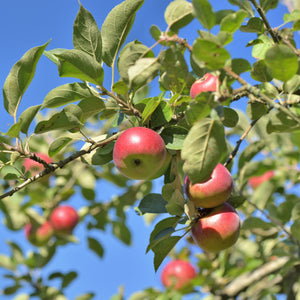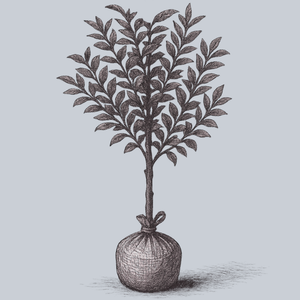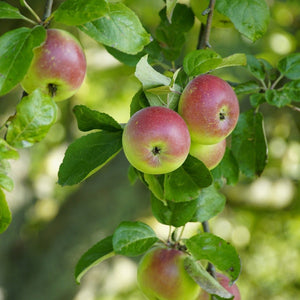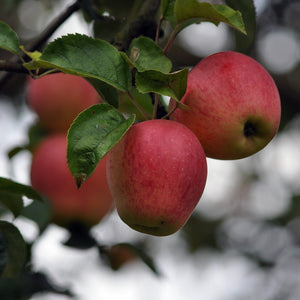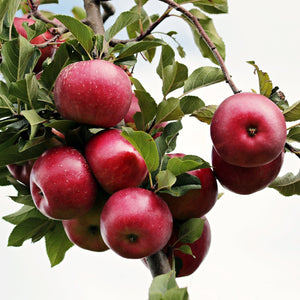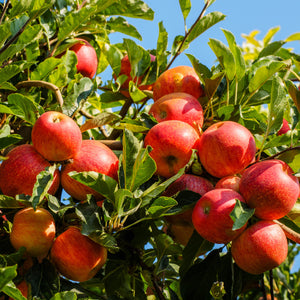The Apple Tree Guide
Apple trees bring a timeless and enchanting presence to any landscape. With their charming appearance, distinctive fruit, and vital role in gardens and outdoor settings, apple trees captivate attention and introduce a touch of natural beauty. These remarkable trees are known for their versatility and can flourish in various conditions with the right care and attention. Whether you aim to establish a serene orchard retreat or desire a delightful centerpiece for your garden, apple trees are an excellent choice to consider.
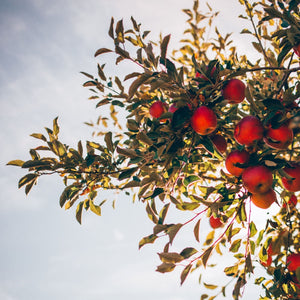
About
Apple trees, belonging to the Malus genus, comprise a diverse group of deciduous trees celebrated for their compelling presence and ecological importance. With numerous species found across temperate regions in the Northern Hemisphere, including North America, Europe, and Asia, apple trees stand out for their distinctive characteristics and critical roles in local ecosystems.
One of the standout features of apple trees is their captivating bark, which can vary in color but often provides an eye-catching contrast against their lush foliage. Apple tree leaves are typically ovate with serrated edges, showcasing vibrant shades of green during the growing season. As autumn approaches, these trees undergo a striking transformation, adorning themselves in a splendid array of warm hues, ranging from golden yellow and fiery orange to rich copper tones.
Apple trees have a recognized ecological significance, providing sustenance and refuge for a wide array of wildlife. Their blossoms, appearing in small clusters in spring, serve as a crucial early source of pollen for pollinators like bees and other beneficial insects. Furthermore, the seeds, encased within their characteristic fruits, offer valuable nourishment to numerous bird and mammal species.
These adaptable trees can thrive in various soil types and environmental conditions. While they favor well-drained and moderately moist soil, apple trees demonstrate resilience in both full sun and partial shade. Their capacity to withstand varying climatic conditions and their moderate growth rate make them a fitting choice for landscaping projects.
Whether featured as a prominent centerpiece in a garden, grouped to create natural windbreaks, or thoughtfully integrated into mixed borders, apple trees infuse elegance and natural beauty into any landscape. Noteworthy species include the common apple (Malus domestica) and wild apple varieties, each cherished for their aesthetic appeal and significant contributions to the environment.
When you select and nurture apple trees in your landscape, you not only enhance the visual allure of your outdoor space but also contribute to the preservation of these exceptional trees and the biodiversity they support.
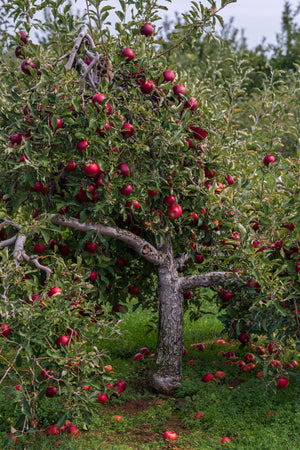
Planting
Apple trees, members of the Malus genus, come with specific planting requirements that are essential for their prosperous establishment and growth. Here are some fundamental guidelines for planting and caring for apple trees:
Soil: Apple trees thrive in well-drained soil rich in organic matter. They particularly favor slightly acidic soil with a pH between 6.0 and 7.0. It's advisable to prepare the planting site by loosening the soil and incorporating compost or organic matter to enhance both drainage and soil fertility.
Sunlight: Apple trees prefer full sun, where they receive a minimum of six hours of direct sunlight each day. However, they can tolerate partial shade, which can be especially valuable in regions with hot and arid climates.
Watering: Adequate and consistent watering is crucial during the initial establishment of apple trees. Immediately after planting, it's important to water the tree deeply. This regular irrigation should continue throughout the first year. Water deeply and thoroughly once or twice a week, depending on natural rainfall and soil moisture levels. Be cautious not to overwater, as excessive moisture can lead to root rot.
Mulching: Applying a layer of organic mulch around the base of your apple tree is beneficial. Mulch helps in conserving moisture, suppressing weed growth, and maintaining consistent soil temperatures. Wood chips, bark, or compost are all suitable mulch materials. Ensure the mulch is kept a few inches away from the tree's trunk to prevent excessive moisture accumulation.
Pruning: Apple trees generally require regular but minimal pruning. It's recommended to remove dead, damaged, or crossing branches to maintain a robust and balanced framework. Pruning is most effective when done during late winter or early spring while the tree is dormant, before new growth emerges.
By adhering to these essential planting and care guidelines, you can ensure that your apple trees establish themselves successfully and grow healthily. This diligence will allow them to thrive and bring beauty to your landscape for many years to come.

Care
Apple trees, belonging to the Malus genus, also require specific care to ensure their optimal growth and health. Here are some fundamental guidelines for the care of apple trees:
Watering: During the growing season, it's important to provide adequate watering for your apple trees. Aim for about one inch of water per week, adjusting as necessary based on rainfall. Deep and thorough watering is key to promoting deep root growth. Shallow watering should be avoided, as it can lead to stress and dehydration for the trees. In periods of drought or high temperatures, consider additional watering to maintain sufficient soil moisture.
Pruning: Apple trees, like beech trees, typically do not require extensive pruning. Nevertheless, it's advisable to remove any dead or damaged branches to maintain the tree's overall health and appearance. Shaping the tree to achieve your desired size and form can also be done. Pruning is most effective when carried out during late winter or early spring, prior to new growth emerging. Be sure to use clean and sharp pruning tools to minimize the risk of damaging the tree. Additionally, deadheading spent flowers can encourage new growth and possibly trigger a second blooming.
Fertilizing: Fertilizing can support healthy growth and fruiting in apple trees. Apply a balanced, slow-release fertilizer in the spring or early summer, following the recommended application rates and timing provided by the manufacturer. It's crucial to avoid over-fertilization, as this can harm the tree's roots. When in doubt, it's often wiser to use less fertilizer to prevent any potential harm.
Soil and Sunlight: Apple trees thrive in well-drained, moist soil and flourish in full sun exposure. They exhibit a degree of tolerance to different soil types, but well-draining soil is a critical factor for their optimal growth. Applying mulch around the tree's base can assist in retaining moisture and regulating soil temperature, as with beech trees.
Pests and Diseases: While apple trees are generally hardy, it's essential to be vigilant for common issues such as apple tree borers, aphids, and diseases like apple scab or powdery mildew. If you notice signs of damage or disease, swift treatment with suitable insecticides or fungicides is recommended.
By adhering to these basic care guidelines, your apple trees will thrive, offering beauty, shade, and a source of delicious fruit in your garden for many years to come.
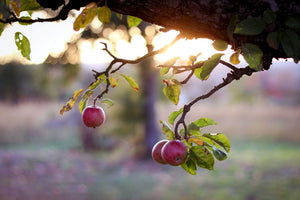
How To Use
Apple trees are a versatile and delightful addition to any landscape, offering numerous possibilities to enhance your outdoor space. Here are some recommendations based on their characteristics:
Fruitful Centerpiece: Apple trees can take center stage in your garden, providing both aesthetic appeal and delicious rewards. Plant a single apple tree as a focal point in an open area, and it will not only captivate with its charming blossoms and vibrant leaves but also yield a bountiful harvest of apples. Alternatively, create a small orchard by planting several apple trees together, forming a productive and picturesque centerpiece in your landscape.
Shade and Relaxation: Apple trees are known for their broad and leafy canopies, making them an excellent choice for creating comfortable outdoor spaces. Strategically plant apple trees near patios, decks, or outdoor seating areas, providing natural shade for relaxation during sunny days. These inviting spots will become your favorite places to unwind while enjoying the fruits of your labor.
Wind Protection: Apple trees, with their robust growth and dense foliage, can effectively serve as a windbreak. Plant them in a row, and they will act as a natural barrier, shielding your garden, home, or outdoor living spaces from strong winds. This not only protects your property but also adds a touch of beauty and tranquility to your landscape.
Privacy with a View: Utilize the lush foliage of apple trees to create a natural privacy screen in your outdoor haven. Line them along your property's border, and in addition to enhancing your privacy, they will add a touch of aesthetic charm. These blossoming barriers not only provide seclusion but also offer delightful views when they burst into bloom.
Wildlife Attraction: Apple trees contribute to your garden's biodiversity by attracting various wildlife species. Birds and critters are drawn to the fruit and the shelter provided by these trees. Embrace the enchanting sight and sounds of wildlife thriving in your outdoor space by planting apple trees.
When choosing apple trees for your landscape, consider their growth habits and environmental needs. Make sure they are planted in locations that receive ample sunlight, preferably full sun, and offer well-drained soil. With their captivating blossoms, delicious fruit, and diverse benefits, apple trees make an exceptional addition that enhances both the beauty and functionality of your outdoor environment.
Conclusion
Apple trees are a captivating and versatile addition to any landscape. Their exceptional presence, unique fruit, and ecological importance make them a sought-after choice for various settings. By adhering to proper planting and care practices, you can enjoy the beauty and benefits of apple trees in multiple ways, whether it's cultivating your orchard of delicious fruit or creating a serene corner in your backyard. Whether you choose to showcase their charming blossoms as a focal point or integrate them into a larger garden design, apple trees offer a myriad of possibilities to enhance the allure of your outdoor space. With dedication and care, you can create a fruitful landscape that will bring you lasting joy for years to come.


